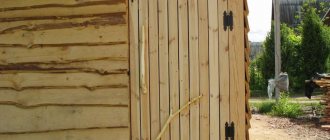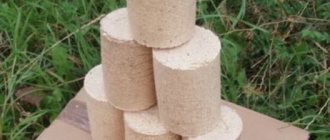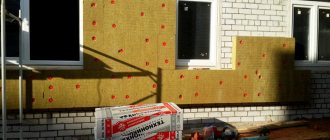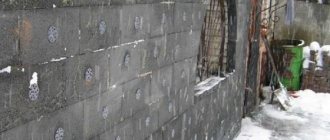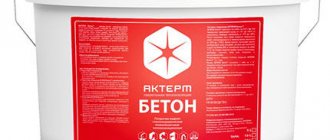Perhaps someone will decide that sawdust as insulation, in our age of high-level artificial materials and enormous technical capabilities for their creation, is far from the best idea. There is mineral wool, polystyrene foam, and polyurethane foam. All these materials retain heat very effectively and are also easy to install.
But, despite all the advantages, they also have one major drawback - the high price. If the volume of work is large, then high cost can become a significant problem. And here, as an alternative to expensive insulation materials, the “grandfather’s” method of insulation using sawdust comes to the rescue. This material is not only not expensive, but also environmentally friendly. Of course, it is not necessary to use sawdust in its pure form - materials made from it are perfect.
Technical properties of sawdust
The quality of sawdust insulation is on par with other materials. It is characterized by the following technical properties:
- The raw materials contain only organic components that have a porous structure.
- Moderate degree of flammability.
- High level of thermal and sound insulation.
- Environmental safety, since the insulation is completely natural.
- Duration of operation – up to 40 years.
Sawdust is a cheap raw material that is used in buildings for various purposes. You can install it yourself.
Features of the material, advantages and disadvantages
Thermal insulation with sawdust is more often used in private low-rise construction. Raw materials have the following advantages:
- environmental cleanliness;
- low level of thermal conductivity;
- good sound insulation properties;
- low cost;
- ease of installation;
- light weight, so the load on the floor slabs is insignificant.
You can increase the service life of the insulation if you treat it with fire prevention agents, as well as antiseptics. Chips have disadvantages: they absorb moisture and can rot under its influence. Wood waste also has a high level of flammability. If sawdust insulation is laid in violation of technology, it can be damaged by insects and rodents.
Additional components can improve the properties when insulating walls or other parts of a building: copper sulfate, clay, lime, cement.
Conclusion
Of all the options, wood chips are the most environmentally friendly material. It has good thermal conductivity and sound insulation properties, which means it can be used along with technologically advanced analogues. If you correctly approach the improvement of the properties of this material, you can achieve increased fire resistance, moisture resistance, and extend the service life.
This becomes possible thanks to treatment with antiseptics and fire retardants. In addition, proper installation will help reduce the intensity of heat outflow from the room when using sawdust: layer by layer with a tamper.
The use of natural thermal insulation materials not only ensures warmth and comfort of living in a private home, but also guarantees complete environmental friendliness and hygiene of the materials used. Sawdust is very popular as insulation, which has an affordable price, is completely safe to use and provides high-quality thermal protection for the room.
Scope of application of sawdust insulation
Before insulating walls with sawdust, the pros and cons of the material are known; you need to know that they are also used to insulate ceilings, roofs, and floors. The technology for carrying out the work may differ slightly.
Walls
More often, wood shavings are used as wall insulation . Sawdust helps reduce building construction costs. First, wood waste is treated with a fire retardant, and chimneys, sockets, and switches are protected with fireproof material. Electrical wires in insulating tubes. The thickness of their walls is 3 mm.
To insulate the walls from the inside of the attic, you must first build a frame into which sawdust will be poured. Slats and wood lathing are fixed to the base. The best material for wall insulation has a coarse fraction. Additional components of the mixture are: water, lime, boric acid, cement. After preparing the solution, it should not crumble. By pouring insulation into the frame on the attic wall, it is compacted to prevent subsidence.
Floor
Sawdust is used as insulation to improve the insulating properties of the floor of a house or attic. The shavings are first prepared: left for about 2 months, mixed with binding components and an antiseptic solution. All insulation components are thoroughly mixed. The thickness of the insulation layer is at least 30 cm. If the attic room will be used only in warm weather or the temperature in winter is not lower than -20 degrees, then this figure is reduced to 15-20 cm.
When insulating the floor, the old covering is removed, and the joists and beams need to be checked for rotten parts or broken fragments. The frame is additionally coated with an antiseptic. The mixture for insulating the attic floor is prepared in small portions. When insulating a house with sawdust, heating pipes and electrical wires are additionally insulated.
The mixture with sawdust is placed on the covering material. After applying the insulation, it should be left for 14 days until fully matured. The attic is regularly ventilated during this period. After 2 weeks, the layer should be checked for voids and filled.
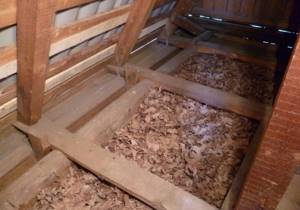
How to insulate walls with sawdust
Creating reliable thermal insulation from natural wood material between frame walls is a rather complex process. Large chips mixed with lime and gypsum are used. A waterproofing sheet is placed between the partition and the insulation. The mixture is moistened and laid manually in layers of 25-30 cm, making sure to compact well. Due to subsidence, voids can form that allow cold to enter. Thermal insulation should fill the entire space of the frame; its thickness is from 15 to 30 cm. It will take about 1 month until the composition completely hardens.
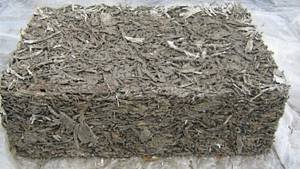
Recommendations for the selection and use of sawdust:
- When choosing shavings, its appearance is assessed; you should not purchase material with a large number of foreign objects. Existing waste is selected by hand or sifted.
- When using wood waste, it is necessary to take a responsible approach to ensuring fire safety. Where chimney pipes pass through, protection from non-combustible materials is installed, and electrical wiring is placed in special boxes.
- The shavings are treated with an antiseptic against rotting and insects, a fire retardant and water repellents. These compositions must be compatible with each other; the best option is products from the same manufacturer.
- To create an insulating mixture, it is better to use not fresh sawdust, but rather one that has been sitting for 2-3 months. During this time, substances that interfere with the strong binding of the mortar will disappear from the wood, and less cement will be required. If it is not possible to purchase products of the required quality or wait, you can improve the properties of the mixture by adding liquid glass.
- Thermal insulation is recommended to be carried out in the summer, when it is possible to dry the composition well, preventing the development of mold during operation.
- Before adding copper sulfate or other chemicals, you must wear protective equipment.
- Shavings of different types of wood differ in their properties. Pine waste contains a resin that repels insects, so it is used to insulate a home. Deciduous shavings are used to insulate outbuildings.
Ceiling
In addition to insulating the attic walls, the same procedure is carried out with the ceiling, since it is through it that up to 20% of the heat is lost. The rough base must be covered with glassine, and all wooden elements must be treated with protective solutions. Sawdust is poured into a solution of cement and water. Next, the mixture is placed on the surface of the floor slabs and compacted. The insulation process is carried out in warm weather so that the layer dries quickly.
For sawdust insulation to be of high quality, the shavings must be dry. It is better to use raw materials after they have been aged for at least 12 months. If you use fresh sawdust, the cement will not set. The chips must have a medium fraction. Raw materials are also checked for the presence of mold.
Roof
If the thickness of the roofing material in the attic is insufficient or the roof insulation is not done correctly, condensation appears on its inner surface, which has a negative effect on parts of the structure. Before insulating the structure, the wooden parts are impregnated with an antiseptic. Joints and cracks need to be foamed.
You need to spread roofing material between the beams, and the sheets are laid overlapping and secured with nails. Communications, chimney surfaces, and electrical wires are additionally insulated. To insulate the roof, you should choose fine insulation for the attic. In most cases, filling with sawdust requires the construction of a frame.
Preparatory work
Before insulating the roof with sawdust, prepare the selected mixture. All wooden structures are treated with antiseptic impregnation. If gaps are noticed, they are filled with polyurethane foam, and the joints between the ceiling elements are also treated. Rotten and damaged parts of the roof are replaced with new ones.
While the preparatory work is being carried out, the sawdust should be dried. Lime and a little copper sulfate are added to them to protect against pests. Previously, these components were replaced with broken glass and chopped dried tobacco.
On the attic floor, between the beams, spread paper or roofing felt. Sheets of lining material are laid with an overlap. The edges are folded onto the beams and secured with a stapler or wide-headed nails. This ensures that the insulation will remain in place and will not leak into the rooms.
In the case where electrical cables and water supply pipes are laid in the attic, their integrity is checked. The wiring is hidden in special sleeves, and the chimney is covered with fire-resistant compounds. These procedures will protect the house from fire, so they should not be neglected.
Features of insulation preparation
For thermal insulation, it is better to choose small chips, as they have lower thermal conductivity. It is worth noting that such sawdust has a large mass and can fly apart during operation. Therefore, kneading of insulation is carried out in calm weather. And in order not to waste time on drying, choose sawdust from finished carpentry.
Give preference to coniferous wood, it contains resin that repels pests.
If the sawdust requires drying, leave it under a shelter for several days. Then treat with antiseptics and mix with lime in a ratio of 10:1. This will serve as additional protection against insects, mice and rats.
Usually sawdust is mixed on special metal or wooden boards. The entire volume of insulation is simply turned over with shovels until a homogeneous mass is obtained.
Dry method of laying sawdust
The installation process is carried out in two layers. For the first, coarse material is used, for the second - fine sawdust. To insulate the floor in the attic from the inside with your own hands, you need to proceed as follows:
- lay film insulation on the joists;
- fill the subfloor from boards;
- lay an additional layer of insulation;
- pour sawdust and compact well (each layer is done separately, and its thickness is 10 cm);
- Dry the material for 3-4 days, after which the shavings are covered with waterproofing.
The last step is to finish the floor. To insulate the walls, sawdust will need to be mixed with a binder. The drying process of the layer takes 2-3 weeks.
Application of auxiliary astringents
In order for the insulation to be of high quality and durable, sawdust must be combined with binding components. They will not only reduce chip consumption, but also improve its technical characteristics.
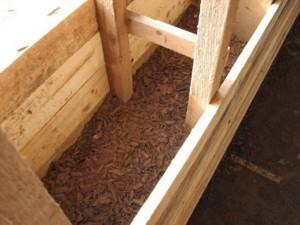
Lime
If the owner cannot decide which insulation to choose for the attic walls so that it is cheap and effective, you can fill the frame with sawdust and lime. Well-dried shavings are mixed with the second component in a ratio of 10:1. Additionally, an antiseptic is added to the composition (25g per bucket). The solution is placed in a pre-prepared frame or space between the walls and compacted. But you shouldn’t tamp it too hard, as this can worsen the technical characteristics of the material.
The use of sawdust with lime as insulation provides good insulation, and the powder increases the fire resistance of the mixture and its resistance to damage by rodents and insects. This method can be used when arranging the floor if laying a plank structure is planned.
Gypsum
A mixture of sawdust and gypsum retains heat well and is light in weight. But she is afraid of water, so when using the material you need to take care of its waterproofing. To prepare the solution, take 8 parts of shavings and 1 part of gypsum. It should be mixed in small portions so that the entire amount of material can be applied. Liquid is added at the rate of 0.7 liters per 1 kg of gypsum. You can also use components that slow down the hardening of the solution.
Cement
You can insulate the attic base with cement mortar and sawdust. An additional component is lime. To prepare the mixture, the following components are taken:
- 10 buckets of shavings;
- 1 bucket each of lime and cement.
After mixing the components, the solution is irrigated with an antiseptic. It should retain its shape well, but not release water. Only in this condition is the use of sawdust with cement as insulation justified. It is better to make blocks from the resulting solution, which are used to insulate walls, roofs, and floors. It takes 2 weeks for the layer to dry completely.

Clay
To make warm plaster, you can mix sawdust with clay, cement, old newspapers and liquid. The substance is most often used to insulate the internal surfaces of attic walls. It is difficult to prepare such a solution manually, so it is better to use a concrete mixer. It should have a medium degree of thickness. You should not add a large amount of shavings, since after drying the clay shrinks greatly.
Before laying the mixture, the base must be covered with waterproofing. The insulation layer is 10-15 cm. It will take 3-4 days to dry. If cracks have formed on the surface during this time, they can be eliminated using wet clay. The solution is applied to a vertical surface in the same way as plaster. The surface of the base is cleaned of dirt, dust and loose fragments.
PVA glue
An insulated house or attic will save money on heating. In addition to the previously mentioned binding components, PVA glue is used. A construction or universal type of substance is better suited here. Sawdust can be fresh, but must be dry. The mixture must be used within 1.5 hours after preparation.
If lightweight insulation is needed, then a smaller amount of glue should be used, although the ratio can be 1:2 or 1:10. To increase the strength of the insulator, you can add a little cement to its composition. To the question: is it possible to use sawdust with PVA glue to treat walls, the answer is clear - no, since the mixture has a low level of plasticity.
When filling the space between the wall and the facade, the internal surfaces are covered with drying oil or a thin film.
Building materials using sawdust
Sawdust is used not only for insulation of walls and other parts of the attic, but also for the production of building materials with good insulating characteristics.
Sawdust concrete
Sawdust concrete contains fine shavings, lime, cement and sand. Its density depends on the ratio of the components. Depending on the technical characteristics, the product is used for the construction and insulation of internal and external walls of dachas, cottages, residential buildings, attics, garages, and outbuildings. Fences or pillars for them are built from sawdust concrete and used to strengthen the foundation.
The material is well processed; various decorative materials can be used for its finishing. If it is manufactured in accordance with technological requirements, then its properties include high fire resistance and resistance to low temperatures. Sawdust concrete provides good sound insulation of attic walls, is easy and quick to install, has a low cost, but slowly gains strength and requires reliable protection from moisture.
Arbolit
Arbolite blocks are made from a mixture of wood chips, cement, and sawdust. The advantage of the product is its high thermal insulation property, strength, and fire resistance of the walls. The block is easy to process. Wood concrete does not crack, even if it is not stored under a canopy, but is subject to slight shrinkage. The product is relatively light and environmentally friendly.
The disadvantage is the inaccuracy of the geometric shape and low resistance to moisture. For finishing wood concrete, only those products that can allow air to pass through are used.
To understand which insulation is best for the attic, you need to decide on its purpose and seasonality of use. Using sawdust, you can well insulate a given room and ensure its impeccable technical characteristics for many years.
Sawdust concrete
- This is a combination of sawdust with the addition of shavings, cement, lime, sand and water. It is widely used in the construction of one- or two-story residential buildings (they are very popular in the Baltic states), in the construction of livestock complexes, and commercial buildings. Sawdust concrete has a lot of positive properties - long service life, undoubted environmental friendliness, fire resistance, excellent heat retention, excellent sound insulation. The only negative is increased water absorption, which is compensated by treatment with water-repellent compounds.

